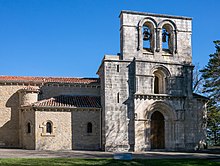Nuestra Señora de Estíbaliz
Nuestra Señora de Estíbaliz is a Romanesque monastery church. It is located outside the town of Argandoña , about ten kilometers east of Vitoria-Gasteiz , in the province of Álava in the autonomous Spanish region of the Basque Country . In the church there is a seated Mother of God with baby Jesus, which dates from the 12th century and is venerated as the patron saint of Álava. Romanesque capitals have been preserved in the church . The south portal, the so-called Porta Speciosa, is particularly worth seeing .
history
The monastery was mentioned in writing as early as 1074. From 1138 it was subordinate to the Benedictine monastery of Santa María la Real in Nájera . The current church was built in the 13th century. After the monastery was dissolved in the 15th century, it was used as a parish church. From the middle of the 16th century, the facility was owned by the Hospital de Santiago de Vitoria-Gasteiz until it was taken over by the province of Álava at the beginning of the 20th century. Subsequently, restoration work began on the church and new monastery buildings were erected, into which Benedictine nuns moved again in 1923 .
architecture
The plan of the church is a Latin cross . The nave has a single nave and extends over three bays . A three-part apse adjoins the transept in the east . There are portals on the west and south facades . The west portal was renewed in the 20th century.
inner space
A slightly broken arch opens to the apse, which rests on massive pillars with half- columns. The fall of Adam and Eve and an annunciation scene can be seen on the capitals . The portrayal of a woman whose breasts are bitten off by a toad and a snake symbolizes fornication. A person with a thick pouch around whose neck the devils are pulling is said to embody avarice.
Sculpture jewelry
The roof of the apse rests on stone slabs that rest on corbels with carved animal representations, plant motifs or geometric figures.
South facade and Porta Speciosa
The reconstructed open bell tower ( Espadaña ) with two large arched openings rises above the south facade . In the middle of the facade there is an arched window with archivolts on pillars and capitals. A cornice resting on carved corbels forms the upper end of the portal. This is framed by slightly pointed archivolts and columns with leaf motifs, the shafts of which are decorated with braided ribbons . Leaves rolled into volutes are depicted on the capitals and, like on the relief panels of the garment, people are embraced by leaf tendrils. On the right side of the portal, at the height of the archivolts' approach, the Annunciation of Mary by the Archangel Gabriel is depicted.
Furnishing
The figure of Mary in the apse, the Virgin of Estíbaliz ( Virgen de Estíbaliz ), dates from the 12th century and is venerated as the patron saint of Álava.
The baptismal font is from the 13th century. It is decorated with stylized leaves. Human heads and animals are framed by pillars and three-pass arches that are supposed to point to the heavenly Jerusalem .
literature
- Jaime Cobreros: Las Rutas del Románico en España . Vol. II, Madrid 2004, ISBN 84-9776-112-X , pp. 308-310.
Web links
- Nuestra Señora de Estíbaliz (Spanish)
- Nuestra Señora de Estíbaliz (Spanish)
Coordinates: 42 ° 50 ′ 53.6 " N , 2 ° 34 ′ 12.1" W.




